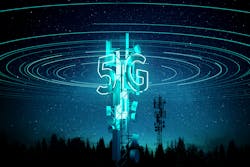Part 90 vs Part 20 Regulation for 5G Signal Boosters
The migration to high throughput 5G networks promises to be nothing short of revolutionary in terms of the applications it will enable for businesses and consumers alike. Allowing higher bandwidth applications to run at low latency at the network edge, 5G promises to drive the next wave of digital transformation, unlocking productivity and unprecedented efficiency enhancements in the process.
As PwC puts it, “The positive impact of the Fourth Industrial Revolution and its related emerging technologies will be fully realized through the wide-scale deployment of 5G communication networks in combination with other connectivity solutions.” According to the consultancy, 5G will unlock $13.2 trillion in global economic value by 2035 while generating 22.3 million jobs.
Although public LTE can meet consumer needs now, eventually more businesses will need 5G to enable their devices with higher throughput and speed. Businesses in sectors like manufacturing, warehousing, and distribution particularly stand to benefit from 5G. By leveraging the power of 5G, manufacturers and carriers will be able to build a new generation of “smart” factories and unlock greater benefits of technologies such as automation, artificial intelligence (AI), Virtual Reality (VR), and the Internet of Things (IoT). It’s little wonder that 91% of manufacturers believe that 5G connectivity will be important to the future of their business. (Source: https://www.nam.org/how-5g-is-transforming-manufacturing-13212/?stream=series-demystifying-data)
A Boost to 5G Patchiness?
However, there is a significant caveat to this story. 5G, like any cellular network, will not offer completely uniform coverage and performance across the whole of the network area. There will, of course, be areas where coverage is patchy. This patchiness largely results from the economics of deploying base stations—rural areas usually fare worse than urban areas when it comes to network coverage due to the costs associated with provisioning higher band base stations to remote, sparsely populated areas.
An important consideration for all stakeholders in the nationwide rollout of 5G is how to improve coverage for consumers and businesses to ensure fair access to the benefits of 5G. A manufacturer in a rural area should not be deprived of a smart factory model purely because there are fewer base stations in their locale, and nor should consumers in such locations be robbed of high-bandwidth Web3 mobile experiences.
Historically, signal boosters have solved coverage issues by optimizing cellular and public safety coverage in businesses, residences, and transportation networks. From plug-and-play devices to enterprise-grade cellular coverage solutions that don’t require carrier approval, these devices are relatively simple to use and have been deployed widely in businesses and homes across the US. However, unless action is taken, these devices will not be available for 5G deployment like they are for LTE networks; an eventuality that risks creating a digital divide between businesses and communities without access to great 5G connectivity and those with it.
The issue stems from how signal boosters are regulated. Leasing spectrum from the federal government is a costly business, and these carriers have a right to protect their investments. For this reason, carriers have traditionally required companies or individuals wishing to regenerate or utilize network signals to sign a retransmission agreement, which is a complex and time-consuming process. However, some regulatory dispensations have been made.
As PwC puts it, “The positive impact of the Fourth Industrial Revolution and its related emerging technologies will be fully realized through the wide-scale deployment of 5G communication networks in combination with other connectivity solutions.” According to the consultancy, 5G will unlock $13.2 trillion in global economic value by 2035 while generating 22.3 million jobs.
Part 20 vs Part 90 Sending the Wrong Signals?
As per Part 20 of Title 47 of the Code of Federal Regulations (CFR), organizations and individuals are permitted to use signal boosters for consumer as well as enterprise installations as long as they remain within strict limits defined by the FCC, including limits pertaining to the frequency bands in which the signal boosters may operate. (Source: https://www.ecfr.gov/current/title-47/chapter-I/subchapter-B/part-22/subpart-H/section-22.913)
In practice, most signal boosters for 4G fall within the regulatory dispensation set out in Part 20, enabling businesses and individuals to boost their cellular signal at will and support a variety of applications. This has been an important win given the complexity of seeking retransmission approval from carriers. The fact is that few, if any, consumers and few small-to-medium-size enterprises (SMEs) have the wherewithal to successfully negotiate a retransmission agreement. Moreover, carriers would not be able to engage with the large number of retransmission agreement requests that would come in from SMEs, and consumers and would likely refuse all such requests.
However, while some current 5G applications can be supported by Part 20 devices, this will not remain the case as 5G evolves and operators look to utilize new 5G frequency bands for higher bandwidth applications. These frequency bands, such as the 2.5GHz band used extensively by T-Mobile, and C-band used by AT&T and Verizon, have the most available bandwidth, and therefore the capability to allow for the delivery of 5G services, such as ultra-fast data connections.
To deploy signal booster solutions on these frequencies, a retransmission agreement is needed as the operation of these devices fall under FCC Part 90 rules. When deployed in big areas such as sports stadiums, airports, shopping malls and concert venues, it is possible to obtain the required retransmission agreements as the mobile network operators are typically deeply involved in the design and deployment of capacity solutions. Other SMEs looking to expand in building coverage may not find the process so easy.
The issue with 5G, is therefore that the higher throughput bands used in these networks to enable the sort of game-changing applications business and consumers demand require signal boosters capable of operating on the wide bandwidth mid-band spectrum. As a result, those solutions automatically fall within Part 90 and require that businesses and consumers first seek retransmission approval before using signal boosters. In effect, this will mean that people and small businesses in areas with poor 5G coverage will have no way of improving this coverage. Unable to negotiate the complexities of retransmission agreements, the full benefits of 5G will remain out of reach for many.
Today, most applications can be supported by devices classified under Part 20. However, this situation will change fast. New enterprise and consumer applications will rapidly emerge and many of these will demand the highest possible throughput rates to be effective. From IoT to VR, advanced AI applications to high-performance cloud computing, we cannot create an environment where access to these and other tools is determined by geography and organization size alone.
A Fresh Regulatory Review
For this reason, it is vital that the FCC looks urgently at the current stipulations of Part 20 to see how these can be adapted to the world of 5G. Signal boosters for higher bandwidth 5G applications absolutely must be included within Part 20 to ensure that everyone has access to the full benefits of 5G no matter where they are based or whether they have the people needed to negotiate complex retransmission agreements.
5G does have the power to change the world. We all need to make sure that it equally changes the world for all.
About the Author
Stephen M. Kowal
Chief Commercial Officer, Nextivity
Stephen M. Kowal is Chief Commercial Officer, Nextivity. Stephen is a technology industry veteran who has held strategic roles in sales, channel, and global accounts for nearly 25 years. As CCO, Stephen is responsible for the company’s customer and partner facing teams, specifically those focused on sales, business development, marketing, product management, and customer service. For more information, please email [email protected] or visit https://www.cel-fi.com/. You can also follow Stephen on LinkedIn: https://www.linkedin.com/in/smkowal/ and Nextivity on LinkedIn: https://www.linkedin.com/company/nextivity/.


